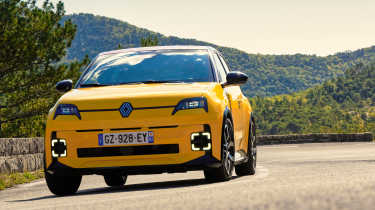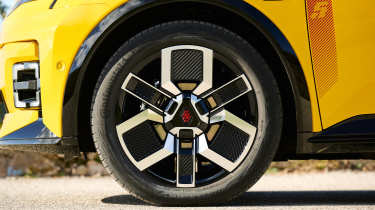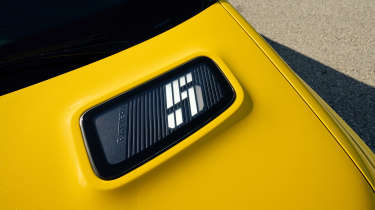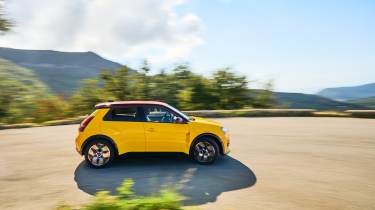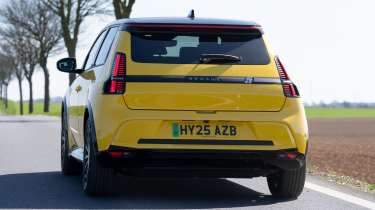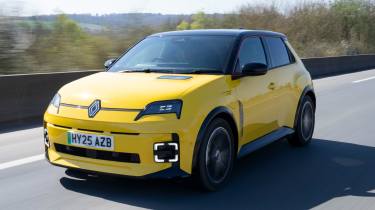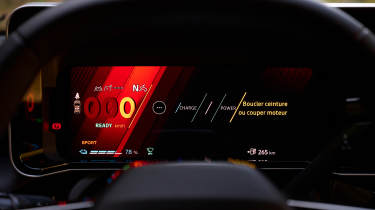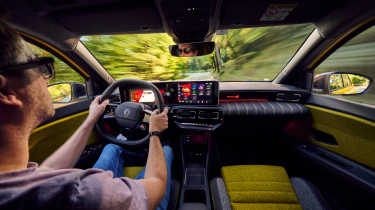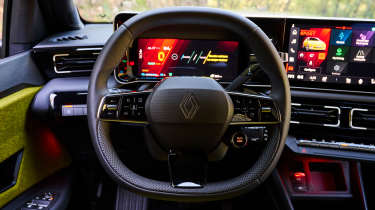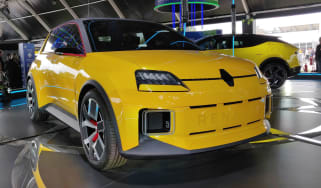Renault 5 2025 review – believe the hype about the EV you might actually want
Almost a year since we first drove it, does the new Renault 5 still impress beyond the hype? Absolutely.
evo verdict
To say that the Renault 5 has changed the way people think and feel about EVs would be inaccurate. The 5 is an EV that resonates with people, as an object of intrigue and desire that more than any before it, transcends its powertrain.
Look in any comment section below a Renault 5 post and you’ll see people saying ‘I really like this, even though it’s an EV’, ‘I would have this, even though it’s an EV’. It’s probably the first electric car ever to break through the negative sentiments of what was a seemingly impermeable and sceptical majority. People’s minds aren’t changed about EVs because of the Renault 5. They just like the Renault 5.
With style however has to come substance and the little French hatch delivers in spades – it’s this that has sustained the Renault 5’s success in the wake of the initial hype, kept the orders coming in and kept the factory pumping them out at full capacity. Not only is it irresistibly stylish, but it drives well, it’s nicely appointed, well equipped, technically competent in terms of its range and charging and above all else, relatively affordable, especially now it qualifies for the new Electric Car Grant… Not only do you want it more than the alternatives from Peugeot and Mini, it’s objectively better – it’s a car about which your heart and your head can sing in concert. The Renault 5 is a car from which all other manufacturers struggling with EV sales could earn an awful lot. Make it desirable, make it good, make it make sense.
Engine, gearbox and technical highlights
- Max of 148bhp
- 252 mile range (claimed)
- Multi-link rear suspension
In many ways the new 5 is entirely conventional. It’s a shade under four metres long, making it shorter than a modern Clio (for a more familiar frame of reference, it’s nigh-identical in width to an old Renault Sport Clio 197, a couple of inches shorter, and an inch taller), has five doors, and four-and-a-bit seats. It sits on an all-new platform, called AmpR, and uses conventional steel construction, though use of multi-link rear suspension is a notch more sophisticated than most B-segment cars.
As tested in top-spec E-Tech 150 Iconic trim (£29k), it has a 148bhp motor driving the front wheels, a 52kWh battery pack slung underneath for a 252-mile WLTP range, and tips the scales at a chunky-for-a-supermini but not-bad-for-an-EV 1456kg. A hybrid Clio E-Tech comes in at 1323kg, so in some respects the usual EV bloat hasn’t made a huge difference, though it’s not a kerb weight, nor a power-to-weight ratio at around 100bhp/tonne, likely to get Jean Ragnotti hot under the collar. A the entry to the Renault 5 range UK buyers will find the 118bhp 40kWh model good for 192 miles of range.
We don’t usually dwell on aesthetics, but given the splash it makes everywhere you go, and given it’s sure to be one of the reasons people will buy the 5 over other electrified superminis, it’s probably worth at least a paragraph or two. To these eyes it looks fabulous, more hot-hatch than most actual hot hatches, and even better in the metal than in pictures. Beyond the raw aesthetic appeal, it’s actually a masterful exercise in design to disguise bulk. The R5 is quite tall to the point that you sometimes find yourself eye to eye with crossover drivers at traffic lights.
Renault’s keen not to call it a retro design, and while it obviously draws inspiration from its 1970s-1990s namesake, you could strip away all the historical baggage and still be staring at a sharp, distinctive and exquisitely detailed shape in its own right.
Retro references include the basic trapezoidal shape common to all 5s, a hint of the old car’s rectangular headlamps in the new car’s lights, and the vertically mounted tail lights. Then there are the flared arches, square daytime running lights in the bumper, and an up-and-over detail around the roof that respectively nod to the 5 Turbo’s box arches, fog lights and roof spoiler.
Squint a bit and you could call the hidden rear door handle a throwback to the original car’s inset handles too. You can get the new 5 in black or white, but you’ll be doing the world a disservice if you don’t opt for this car’s Pop Yellow, the similarly vivid Pop Green, or the Renault Clio Williams-style Midnight Blue.
Performance, ride and handling
- Exceptional refinement
- Quality if not thrilling dynamic feel
- Plenty of performance for daily use
Bright yellow and angular it may be, but calling a new Renault 5 E-Tech a supercar would be generous. It’s too tall, too short and too narrow, powers its front wheels, runs on electrons, and makes a mere 148bhp. The cars we’ve been driving, whether through rural Nice or across the A406 in North London, weren’t the crazy rear-driven, 500bhp R5 Turbo 3E, nor the warmed-over Alpine A290. They were the standard Clio-sized (and priced) £23k family hatch. But for all the attention these cars get, you might as well have been in something low-slung, mid-engined and thirsty for hydrocarbons.
Perhaps because the Five is front-drive only, Renault has programmed some build-up into the way it steps off the mark. There’s not the neck-snap you get from some electric cars, but there’s enough torque to give your hands something to do if you accelerate hard from rest or out of a tight corner. It’ll spin its wheels on damp surfaces, or out of junctions and hairpins too, so it has its moments of hot-hatch yobbery, and feels good for its claimed eight-second 0-62mph time.
Cycling between Normal, Eco, Sport and ‘Perso’ does the usual things: with no active dampers and no sound generator that I could find, it’s effectively limited to changing steering weight, accelerator response, and – in Eco mode – pegging back the air-conditioning, power and top speed to save energy.
After about ninety seconds in Normal you end up switching to Sport for your first few exploratory miles in the Renault 5. Happily, it does also retain whatever mode you set it to when you come back having gotten out and left it. Sport mode, or having the sport setting for the powertrain in the customisable Perso mode, makes the low-end acceleration a touch more responsive while the extra steering weight is welcome. Plus, being an electric car, Sport doesn’t mean the car will bellow brainlessly through villages at 6000rpm in second gear as a dual-clutch hot hatch might when in a rortier driving mode.
The hills and mountains of the Côte d’Azur are a great place to exercise small hatches, and the 5 certainly gave it a go. The surprisingly taut but nicely damped ride showed promise, as did the stiff-feeling structure and minimal body roll. Those talents thankfully remain present on UK cars and work to great effect on our roads. At speed the ride is plush and the refinement impressive, though at lower speeds sudden under-wheel jolts come through into the cabin with a rubbery thunk. It certainly doesn't absorb or dismiss every little imperfection.
> The 500bhp Renault 5 Turbo 3E is a rally icon revived
It’s clear, punting the 5 through a few corners, that this is a car set up primarily to be safe and predictable. The steering is keen but not as darty as a Mini. The 5’s weight means it never feels quite as agile as a lighter hatch, and the mass can also catch out the suspension over certain undulations where it takes longer to settle, but conversely the brakes are positive and there’s a feeling it won’t bite if you take a few liberties.
It’s not a hot hatch, to be clear. It’s not an eager, gnashing character. Your mind won’t be blown by any one performance across its dynamic pallet, but you get the sense that all of the behaviours it exhibits have been honed with a detailed approach. You won’t be bothering supercars but instant EV punch away from the lights is an obvious advantage and there’s good ‘in-gear’ pull too, even at motorway speeds. The performance feels well-judged for the UK.
The brake pedal has a welcome firmness, with impressively intuitive integration of friction braking and regen at the pedal, making it more satisfying than the regenerative effect when you lift off in the ‘B’ transmission mode, which isn’t quite strong enough for one-pedal driving. You do tend to leave the regen off and just drive it like you would any other car.
Traction control and ESP intervention isn’t severe but even when you switch it off (just a few prods of the touchscreen menu) and employ the time-honoured hot-hatch cornering technique of ‘bung it in and lift off’ the result is more a steady four-wheel drift than anything that needs steering correction or balancing with the right-hand pedal.
But other than the slightly disconcerting EV sensation of being able to hear the tyres scrubbing around on the asphalt, the 5 still meets you halfway. Grip from the relatively narrow (195-section) and not especially sticky (Continental EcoContact 6Q) tyres is perfectly decent and the low-feedback but well-weighted and sensibly geared steering, smooth powertrain and tied-down chassis mean it’s easy to get into a satisfying flow.
Charging and efficiency
What about efficiency? Being under 1500kg at the kerb the R5 is relatively lightweight for an electric car. No other EV seems to have nailed that precarious equation of finding the right size battery to provide enough range but also keep the weight down. This is a small car after all, not designed for motorway mile munching.
You’ll struggle to achieve less than 3.7 miles per kWh, which roughly translates to a steadfastly dependable 190 miles of real world driving. Drive like a saint, or keep your driving urban and you’ll see upwards of 200 miles or more on a charge – not quite the stated 252 miles but you can attribute that to flaws in the testing procedures and not the Renault itself. No charging session at 100kW takes more than 30 minutes to get it up to 80 per cent either.
Driver’s note
‘You get a sense in every compression it goes through and every twist of the steering wheel that this car’s behaviour and how it communicates with its driver has been agonised over and refined by people who really care and know what they’re doing. It’s not an outright thrilling driving experience because that’s not what its purpose is, but it is a quality driving experience.’ – Ethan Jupp, evo web editor
Interior and tech
- Excellent seats
- Largely quality feel
- Intuitive user interfaces
The R5’s vibrancy continues inside. Top-spec test cars get closest to the designer’s ideal with yellow recycled fabric and yellow piping and stitching splashed across the seats, door cards and dash. The seats are absolutely fabulous, looking like a modern interpretation of the mad, Gandini-designed 5 Turbo buckets, with prominent bolsters (a feature across the range, and something the old Renault brochures once proudly boasted as having a Petale design) and an H-shaped graphic also referencing the seats in the Turbo.
A blocky digital instrument and Google-based infotainment display is hardly novel in 2025 but could be considered a callback to the Turbo’s dash pod, though the original never got a ChatGPT-powered digital assistant called ‘Reno’ – which we assume is pronounced as per the actor from Ronin, but with the infotainment set to English, introduces itself like the city in Nevada.
The padded area in front of the passenger (leatherette here, a denim-style material on other trims) is a more direct reference to the original’s ridged dashboard, and if you’re being generous, the steering column-mounted gear selector (which can be personalised with various 3D-printed designs) might be called a descendent of the earliest 5’s dashboard-mounted gear lever.
Even ignoring the look, first impressions are pretty good. You feel a little perched even with the seat adjusted low, but that’s been a feature of Renault hatches, hot or otherwise, for a while. But the seats are supportive, the fabric feels great, and good height and reach adjustment for the wheel ensures there’s no bother finding a decent driving position, though with the seat set for an average height driver, space for those behind is already getting tight.
That column-mounted shifter makes the right-hand side of the wheel feel a touch busy, and more than once I set the wipers to full monsoon rather than selecting Drive. But, being an EV, this is about the extent of your interaction with it. There’s a little dial on the wheel labelled ‘Multi Sense’ and this is your driving mode selector.
A final congratulatory note to Renault pertaining to the interior, for the nagging speed and lane assistance warnings and how you turn them off. No, it’s not hidden in the screen. Something that perhaps sums up Renault’s incredibly thoughtful approach to every facet of the R5 beyond its people pleasing styling: there’s a physical button – up-down motion with a nice quality action, and everything – to the bottom right of the steering wheel, well within view and close to hand. C’est magnifique.
Price and rivals
For the 5, the key competitor must surely be the now-electric Mini Cooper E, along with others including the Fiat 500e, Peugeot E-208, and Vauxhall Corsa Electric. It’s a bit of a motley assortment, but common themes include pricing that stretches from £22,995 basic (for the 119bhp standard range car) to £28,995 for a 148bhp 'iconic five', supermini dimensions, and a real-world range of between 150 and 200 miles depending on battery size. Given it falls well under the £37,000 threshold, the 5 is also part of the government's new £650 million Electric Car Grant, giving every new buyer £1500 off at the point of purchase. That means a basic 5 can leave a dealer costing the buyer just £21,495.
It’s not a hot hatchback and isn’t being marketed as one. Renault has left the door wide open for the 217bhp Alpine A290 in that respect, and if the 5 feels a little too mild, another seventy horses and a chassis tuned with slightly more adjustability goes some way to fixing that. What you do get with the 5 E-Tech is an immensely likeable electric hatch that drives better than it needs to, will cover a real-world 200 miles on a charge and, for the time being at least, turns more heads than a supercar.
| Motor | Single e-motor, front-wheel drive |
|---|---|
| Power | 148bhp |
| Torque | 181lb ft |
| Weight | 1456kg (103bhp/ton) |
| Tyres | Continental EcoContact 6Q |
| 0-62mph | 8.0sec |
| Top speed | 93mph |
| Basic price (before grant) | £22,995 |
